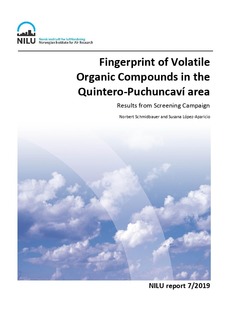| dc.contributor.author | Schmidbauer, Norbert | |
| dc.contributor.author | Lopez-Aparicio, Susana | |
| dc.date.accessioned | 2019-05-08T08:52:00Z | |
| dc.date.available | 2019-05-08T08:52:00Z | |
| dc.date.created | 2019-05-06T14:27:37Z | |
| dc.date.issued | 2019 | |
| dc.identifier.isbn | 978-82-425-2969-5 | |
| dc.identifier.issn | 2464-3327 | |
| dc.identifier.uri | http://hdl.handle.net/11250/2596936 | |
| dc.description.abstract | This report presents the results from a screening study of volatile organic compounds (VOCs) in the Quintero-Puchuncaví region (Chile). Two different methods were selected, one quantitative (canisters samplers / analysis by Medusa/GC-MS) and a second semi-quantitative (Tenax TA/analysis by GC-MS). NILU evaluated the results of 4 compounds (methyl chloroform, nitrobenzene, iso-butane and toluene), which were previously reported at very high concentrations and intensively discussed in the media. NILU’s measurement results show much lower concentrations and it was concluded that the former measurements were done with a significant error in the calibration. The average concentration of ambient benzene was 1.0 µg/m3 at industrial areas and 0.3 µg/m3 at the residential/background areas, both lower than international limit values. The main compounds emitted from the industrial areas are light hydrocarbons, which were detected at low concentration levels. | en |
| dc.description.abstract | Rapporten presenterer resultatene fra målinger foretatt i Quintero-Puchuncaví regionen (Chile) for å kartlegge flyktige organiske forbindelser (VOC). To ulike metoder ble benyttet, en kvantitativ (kanister prøvetaker / analyse med Medusa/GCMS) og en semi-kvantitativ (Tenax TA / analyse med GC-MS). NILU evaluerte resultatene av 4 forbindelser (metylkloroform, nitrobenzen, isobutan og toluen), som tidligere rapporter viste meget høye konsentrasjoner av og som har vært mye omtalt i media. NILUs måleresultater viser mye lavere konsentrasjoner, og konkluderer med at målingene som ble foretatt tidligere ikke ble riktig kalibrert. Den gjennomsnittlige konsentrasjonen av benzen var 1,0 μg/m3 i industriområder og 0,3 μg/m3 i bolig- / bakgrunnsområder, begge lavere enn internasjonale grenseverdier. Hovedforbindelsene i utslippene fra industriområdene er lette hydrokarboner, som ble påvist ved lave konsentrasjonsnivåer. | nb_no |
| dc.language.iso | eng | nb_NO |
| dc.publisher | NILU | nb_NO |
| dc.relation.ispartof | NILU rapport | |
| dc.relation.ispartofseries | NILU rapport;7/2019 | |
| dc.subject | Industriforurensning | nb_NO |
| dc.subject | Industrial pollution | nb_NO |
| dc.subject | Luftkvalitet | nb_NO |
| dc.subject | Air quality | nb_NO |
| dc.subject | VOC | nb_NO |
| dc.subject | Flyktige organiske forbindelser | nb_NO |
| dc.subject | Volatile organic compounds | nb_NO |
| dc.title | Fingerprint of Volatile Organic Compounds in the Quintero-Puchuncaví area. Results from Screening Campaign. | en |
| dc.title.alternative | Fingeravtrykk av flyktige organiske forbindelser i Quintero-Puchuncaví. Resultater fra kartlegging målkampanje. | nb_no |
| dc.type | Research report | nb_NO |
| dc.description.version | publishedVersion | nb_NO |
| dc.rights.holder | © NILU – Norwegian Institute for Air Research. The publication may be freely cited where the source is acknowledged. | nb_NO |
| dc.source.pagenumber | 102 | nb_NO |
| dc.source.issue | 7/2019 | nb_NO |
| dc.identifier.cristin | 1695827 | |
| dc.relation.project | NILU - Norsk institutt for luftforskning: 118110 | nb_NO |
| cristin.unitcode | 7460,52,0,0 | |
| cristin.unitcode | 7460,54,0,0 | |
| cristin.unitname | Måle- og instrumentteknologi | |
| cristin.unitname | By og industri | |
| cristin.ispublished | true | |
| cristin.fulltext | original | |
